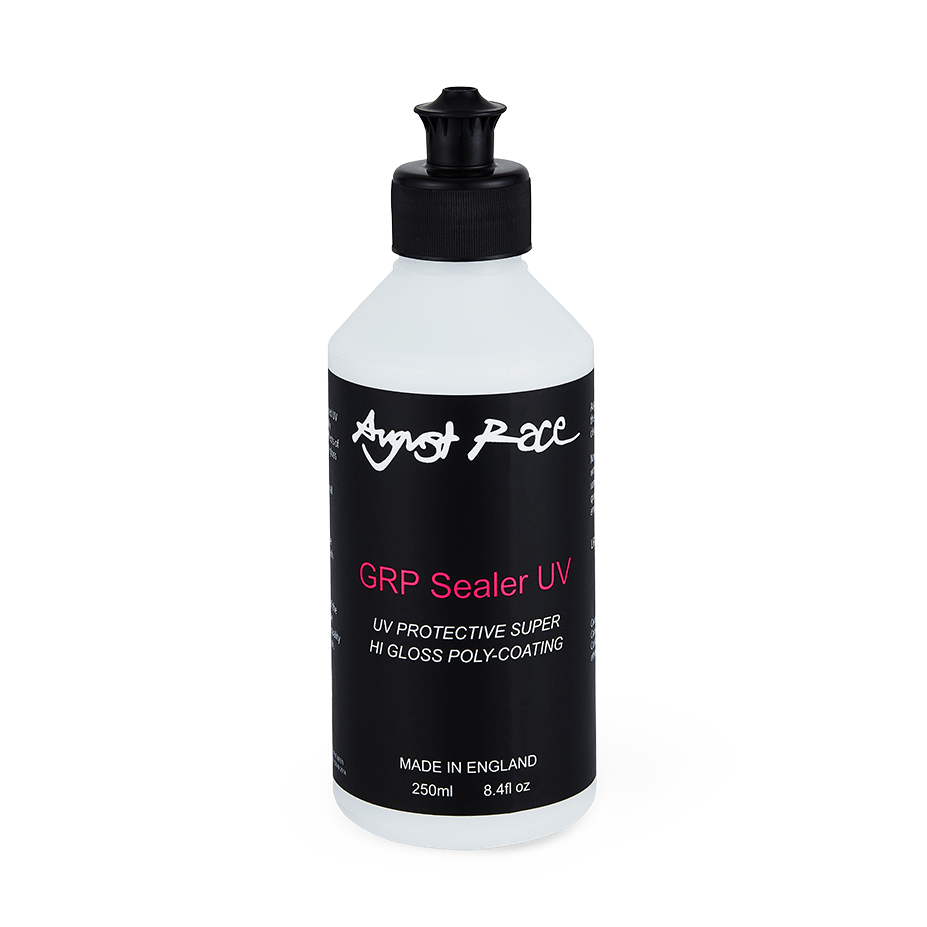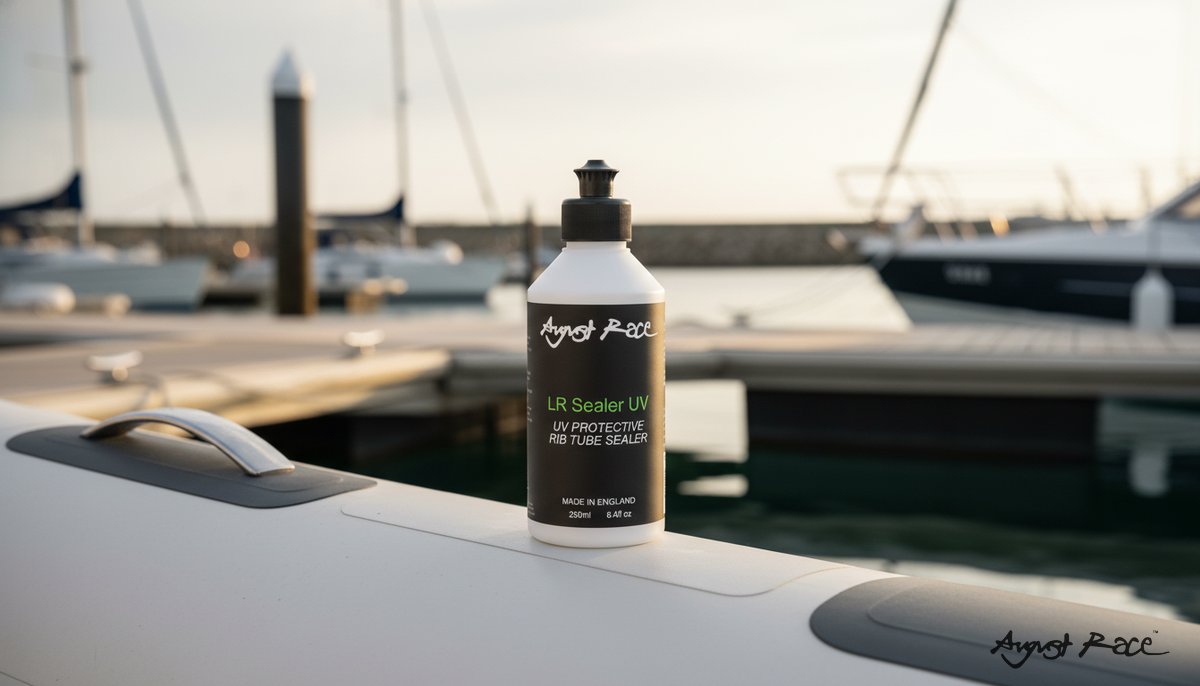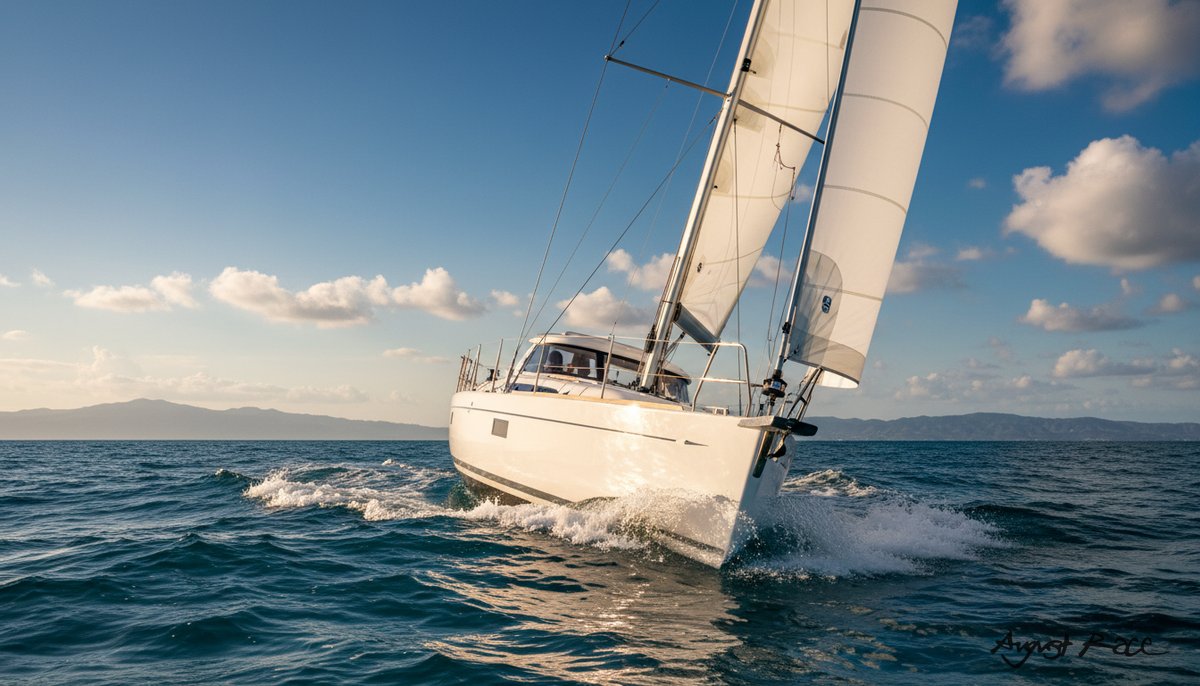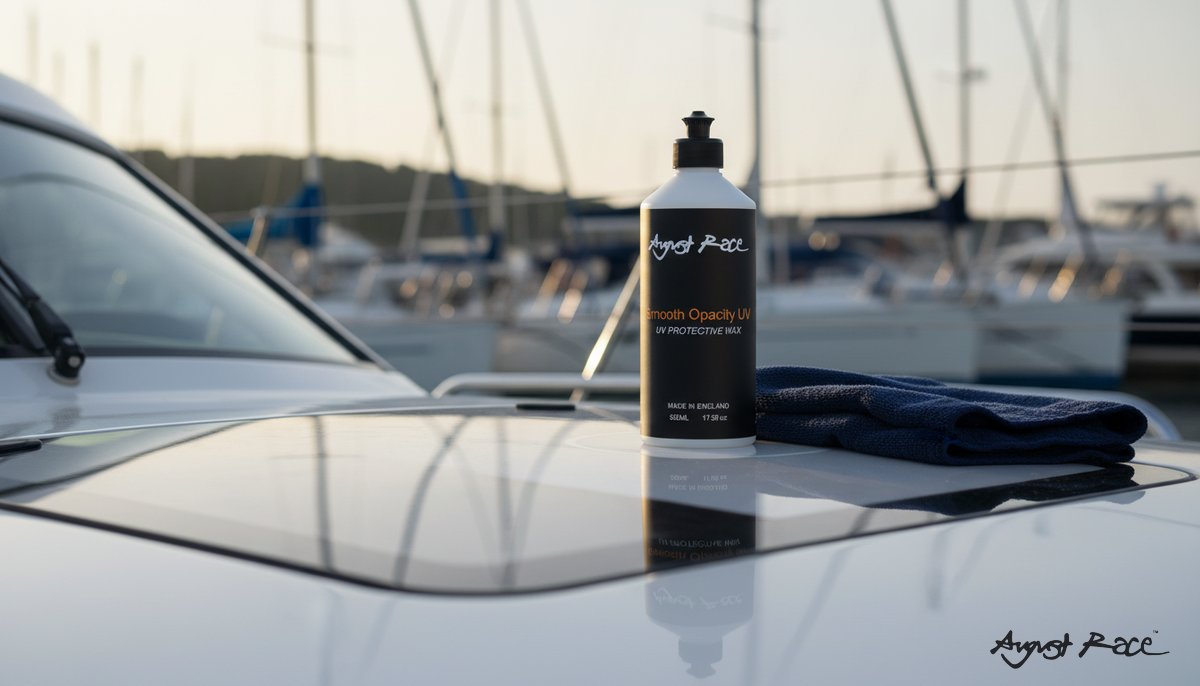How August Race Smooth Opacity UV Protects Gelcoat: A Marine Tech’s Guide to UV Protection Boat Wax
Opening: Morning Inspection -- the UV threat to gelcoat
I start most summer mornings walking the docks with a flashlight and a gloss meter. On south-facing hulls, the story is the same: early chalking, dulled topsides, and tiny micro-fissures in the gelcoat. Without intervention, that surface oxidation (often called “fiberglass oxidation”) accelerates.
UV is the catalyst. It drives photooxidation in the gelcoat’s polymer matrix, breaking chains and producing a friable, chalky residue that scatters light and kills gloss. Left unchecked, water and contaminants penetrate further, complicating any attempt at fiberglass oxidation prevention.
That’s why a UV protection boat wax isn’t cosmetic -- it’s preventive maintenance. The question I ask on the dock is simple: which topical treatment can slow the chain reaction, retain gloss, and buy more time between cut-and-polish cycles? This is where I evaluate Smooth Opacity UV wax as a targeted solution.
Why UV Protection Boat Wax Matters: chemical mechanisms explained
UV-induced photooxidation starts with high-energy photons absorbing into the gelcoat’s polymer network (typically unsaturated polyester or vinyl ester). This creates free radicals that cause chain scission, crosslink disruption, and carbonyl formation. The surface turns chalky as the binder erodes, exposing pigment and fillers.
Conventional waxes mainly act as a sacrificial layer. They provide some UV screening and water repellency, but they erode quickly and offer limited stabilization of the polymer beneath. Advanced blends incorporate UV absorbers that convert UV to heat, and HALS (hindered amine light stabilizers) that quench radicals, slowing the degradation cycle.
For technicians, the metrics that matter are time-to-fade, gloss retention percentage, and reapplication frequency in high-UV zones. A marine gloss enhancer should not only brighten on day one but also maintain measurable gloss units (GU) longer, reduce chalking rate, and extend intervals between abrasive corrections. The right chemistry directly translates to fewer hours behind the polisher and more predictable maintenance planning.
What August Race Smooth Opacity UV is (and isn’t): formulation and compatibility
Smooth Opacity UV wax sits in the class of multi-functional, boat wax with UV protection products. It functions as a hydrophobic boat polish and protective topcoat, engineered to enhance gloss and water repellency while shielding the gelcoat from UV exposure.
In this product category, you’ll typically see a blend of UV absorbers, possible HALS, and hydrophobic surface modifiers (siloxane or fluorinated components) that lower surface energy. Gloss enhancers may include silica or polymeric agents that fill micro-scratches and improve light reflection. Some marine polishes also leverage optical-brightening effects to lift the perceived “pop” without cutting unnecessarily into the gelcoat.
On compatibility, the target substrates are:
- Gelcoat topsides and superstructure (gloss finishes)
- Painted topsides and clearcoats (marine-grade 2K systems)
- GRP components, hatches, and smooth composites
Use caution or avoid on:
- Textured non-skid (can become slippery)
- Raw or oiled teak and porous woods
- Certain soft plastics, vinyl, or EVA foam pads
- Hot surfaces and direct, harsh sun during application
Safety and PPE are standard: gloves, eye protection, and good ventilation. Follow the technical data sheet (TDS) for flash/cure guidance; most polishes prefer cool panels (10–30°C), stable humidity, and shade. Do not mix with other coatings on the same pass; layering unknown products can cause hazing or poor adhesion.
Step-by-step application for lasting protection and gloss
The procedure below is tuned for durability and repeatability. Adjust based on the boat’s condition and local climate.
1) Prepare
- Inspect under raking light to identify chalking, swirls, and micro-fissures. Mark high-wear zones (fender contact, cleats, and boarding gates).
- Wash with an alkaline marine shampoo such as August Race Boat Wash Pro to remove oils and salts. Rinse thoroughly and dry.
- Decontaminate: use a non-abrasive cleaner or marine clay to lift bonded contaminants. A clean substrate improves bonding and the hydrophobic effect.
- Assess oxidation. If a microfiber swipe collects white chalk, plan for at least a light polish before any protective coat.
2) Correct
- Light oxidation/swirl: use a fine finishing polish on a dual-action (DA) with a soft foam pad. Work small sections; keep pad flat.
- Moderate oxidation: step up to a light compound with a microfiber or medium foam pad, then refine with a finishing polish. Avoid aggressive cutting unless necessary; each pass removes a finite amount of gelcoat.
- Machine guidance: DA 4,000–6,000 OPM for finishing; rotary 1,000–1,400 RPM if skilled. Keep panel temps comfortable to the touch and avoid edge burn.
3) Apply Smooth Opacity UV wax
- Panel condition: cool, dry, and shaded. Mask porous trim.
- Product load: thin, uniform films beat thick coats. Aim for coverage that wets the surface without excess.
- Method: hand-apply with a foam applicator in overlapping, cross-hatched patterns, or use a soft finishing pad at low speed on a DA for large panels.
- Dwell/cure: allow the film to haze per TDS guidance before removal. In typical marina conditions, initial set is often minutes, with full cure hours later.
- Layering: two thin coats 12–24 hours apart often yield better uniformity and durability than a single heavy pass. Respect cure windows before adding the second layer.
4) Finish and verify
- Buff off with clean, high-pile microfiber towels. Rotate towels to avoid smearing.
- Verify gloss. If you have a gloss meter (60°), record a baseline GU reading for future comparison.
- Hydrophobic check: rinse the panel. You’re looking for tight, high-beading behavior and fast water runoff -- good indicators common to a hydrophobic boat polish.
This approach helps restore fiberglass shine after sun damage without aggressive material removal, and it sets a clear baseline for future maintenance decisions.
Field performance: durability, hydrophobicity, and real metrics
In service, you’re managing UV, salt, and abrasion. In high-UV coastal regions, expect protective topcoats to require more frequent attention than in temperate zones, regardless of brand. Many professional teams target seasonal reapplication on sun-exposed topsides, with interim “booster” wipe-ons for high-wear areas.
Hydrophobic behavior matters beyond looks. Lower surface energy promotes beading and sheeting, which reduces dirty-water residence time and makes rinse-downs faster. When contact angles are high (typical of a hydrophobic marine coating), contaminant adhesion drops, so you spend less time scrubbing and remove fewer microns of gelcoat over the season.
Common field observations:
- Wear lines at fender points and around hardware where water sits or grit accumulates.
- Dulling near boarding gates and step-throughs from physical abrasion.
- Edge failures where previous coatings overlap or where poor prep left residues.
Maintenance tactics:
- Use fender covers and rinse contact zones often.
- Perform quick top-ups on high-wear areas rather than waiting for whole-boat service.
- Keep a log of gloss readings and beading photos after each wash; when gloss drops materially or beading becomes uneven, plan a refresh.
Troubleshooting and compatibility pitfalls every marine tech should know
Application over contaminants is the number one failure mode. Salt, silicone dressings, and polishing oils can block adhesion and reduce UV efficacy. Always decon thoroughly and, when in doubt, panel-wipe compatible areas before protection.
Watch for signs of incompatibility: persistent hazing, patchy wet-out, or poor adhesion. If observed, spot-test a strip with a full strip-and-recoat sequence: remove the topcoat, refine with a light polish, clean, then re-apply. If the issue clears, proceed panel by panel; if not, test a different pad/product combo.
Decision criteria:
- Re-polish when you see uniform micro-marring or light chalk returning.
- Recoat with Smooth Opacity UV wax when gloss remains good but beading weakens or service intervals dictate.
- Consider structural repair when oxidation has penetrated deeply (severe yellowing, pitting, exposed fibers). At that stage, fiberglass oxidation prevention via topcoats is no longer sufficient -- correction and sometimes re-gel are required.
For longer-term sealing on gelcoat panels where you want a dedicated sealer layer, consider GRP Sealer UV as a complementary option after corrective polishing, following manufacturer compatibility guidance.
Maintenance schedule: integrating Smooth Opacity UV into fleet service
For high-UV regions, build a simple, measurable cycle:
- Monthly: inspection rinse, note gloss uniformity, and perform a quick beading check. Spot top-up high-wear zones as needed.
- Quarterly (or at launch/haul-out): wash, decon, light polish where required, and apply one to two thin coats of Smooth Opacity UV wax.
- Mid-season: wash and evaluate. If gloss has dropped materially vs. baseline or beading is inconsistent, apply a maintenance coat.
Measurable checkpoints keep everyone aligned:
- Record 60° GU readings after application and at each monthly check.
- Capture standardized photos (same angle, lighting, and location markers).
- Note cleaning time per wash; reduced dwell and easier cleanup indicate healthy hydrophobics.
Inventory and storage on service vessels:
- Keep containers sealed, upright, and away from heat/cold extremes.
- Label open dates and rotate stock FIFO.
- Transport with secondary containment; keep PPE and clean applicators dedicated to protective coatings to avoid cross-contamination.
Conclusion and recommended test protocol for marine techs
As a boat wax with UV protection, Smooth Opacity UV wax targets the real failure modes we see on the dock: photooxidation at the surface, gloss loss, and waterborne contamination. Applied correctly, it acts as both a marine gloss enhancer and a hydrophobic barrier to help restore fiberglass shine after sun damage while extending intervals between abrasive corrections.
Run a controlled field test:
- Mask off a representative panel (sun-exposed, mid-height topside). Correct and prep per the steps above.
- Apply two thin coats 12–24 hours apart. Log initial gloss and beading photos.
- Re-check at 1, 3, and 6 months for gloss retention, beading uniformity, and cleaning time. Note high-wear spots and perform targeted top-ups.
Before fleet-wide adoption, request samples and the full technical data sheet and MSDS from August Race. You can also browse August Race products to plan compatible cleaners and sealers for your workflow. Validate compatibility on your substrates, then scale with confidence.
FAQ -- practical answers for techs
How to protect gelcoat from UV damage using a boat wax with UV protection?
Clean, decontaminate, and lightly polish to remove oxidation, then apply a thin, uniform coat of a UV protection boat wax in the shade. Two thin layers 12–24 hours apart generally improve coverage and durability; maintain with periodic wash-and-top-up cycles.
What is the recommended reapplication interval for a hydrophobic boat polish in high-UV areas?
In high-UV, salt-exposed marinas, plan on quarterly full applications for sun-facing topsides, with monthly inspections and spot top-ups in high-wear zones. Actual intervals vary with use, wash frequency, and mooring conditions -- track gloss and beading to time reapplications.
Can Smooth Opacity UV be applied over existing marine clearcoats or paints?
Yes -- on sound, fully cured marine clearcoats and painted topsides after proper cleaning and surface prep. Always perform a small compatibility test and avoid layering over unknown or soft coatings that may haze or smear.
How do I restore fiberglass shine after sun damage before applying a UV protection coating?
Remove the chalked layer with the least-aggressive method that works: start with a finishing polish and step to a light compound only if needed. Refine, clean thoroughly, then apply the protective coat to lock in gloss and slow future oxidation.
About the Author
August Race Team
The August Race professional team brings decades of marine industry expertise and product development knowledge.
Get Expert Tips
Subscribe for marine care insights and product updates from industry professionals.
No spam. Unsubscribe anytime.
You May Also Like

GRP UV Protection: August Race GRP Sealer UV Guide
Protect fiberglass boats from UV with a hydrophobic, eco-friendly GRP sealer. Prep, application, maintenance tips, and FAQs on water spots and durability.

RIB UV Protection: How LR Sealer UV Protects Tubes
Guide to RIB UV protection using LR Sealer UV -- PVC tube sealer and Hypalon UV treatment to prevent UV cracking and reduce cleaning.

August Race GRP Sealer UV: Scalable GRP UV Protection
Protect GRP fleet-wide with a biodegradable, hydrophobic fiberglass sealant. Faster washdowns, longer gloss, and scalable SOPs for busy marinas.
